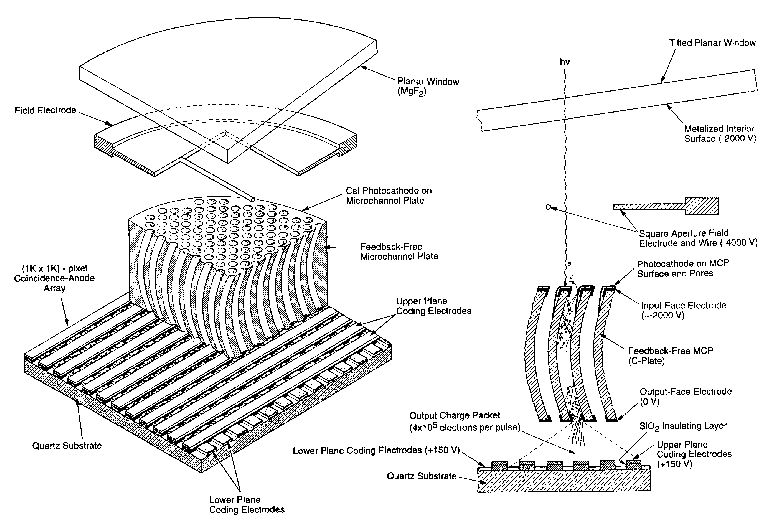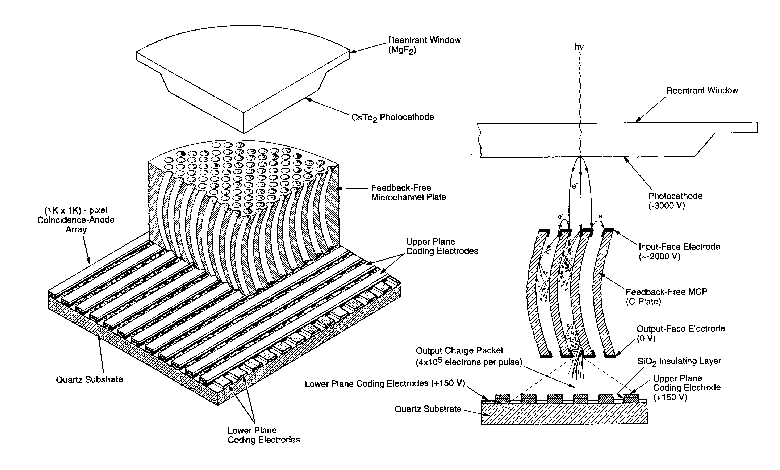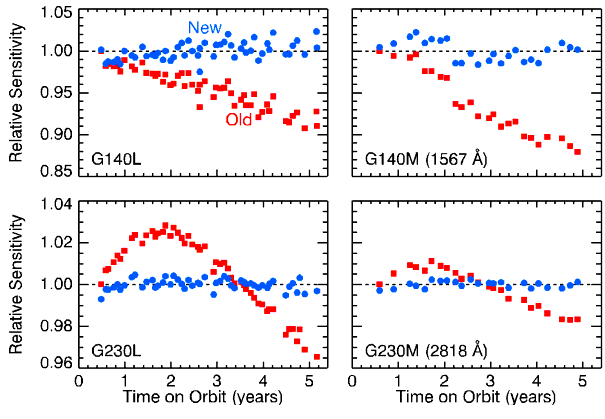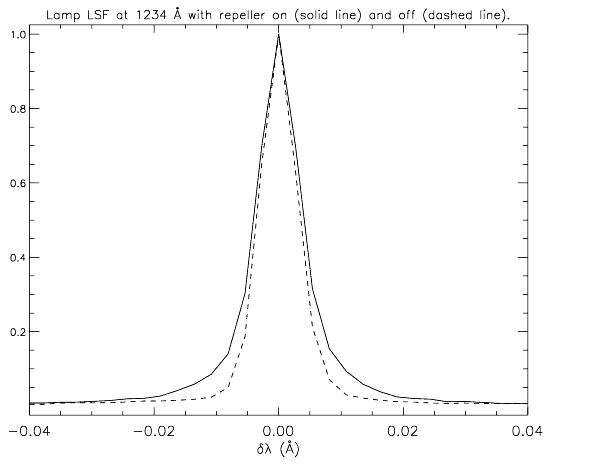



There are two MAMA detectors: the STIS/FUV-MAMA provides coverage from 1150 to 1700 Å and the STIS/NUV-MAMA provides coverage from 1650 to 3100 Å (with lower response to below 1200 Å). The STIS MAMA detectors are photon-counting devices that process events serially. They can be used to take data in either an accumulate (ACCUM) mode in which a time-integrated image is produced, or in a time series (TIME-TAG) mode in which the detector location and time of arrival of each photon are recorded as an event stream (see Section 11.1.2 and Section 11.1.3, respectively). The primary benefits afforded by the STIS MAMAs, in comparison with previous HST UV spectroscopic detectors such as those of the GHRS and FOS, are high spatial resolution, two-dimensional imaging over a relatively large field of view, and low background for point sources. The MAMA detector was developed by J. Timothy and R. Bybee for X-ray and UV imaging applications. The properties of the STIS MAMA detectors are summarized in Table 7.3.
| Characteristic |
FUV-MAMA Performance |
NUV-MAMA Performance |
|---|---|---|
| Photocathode |
CsI |
Cs2Te |
| Wavelength range |
1150-1700 Å |
1600-3100 Å |
| Pixel format |
1024 x 1024 |
1024 x 1024 |
| Pixel size |
25 x 25 µm |
25 x 25 µm |
| Image mode pixel plate scale |
0.0245 x 0.0247 arcseconds (clear) 0.0246 x 0.0247 arcseconds (filtered) |
0.0245 x 0.0248 arcseconds |
| Field of view |
25.1 x 25.3 arcseconds |
25.1 x 25.4 arcseconds |
| Quantum efficiency |
25% @ 1216 Å |
10% @ 2537 Å |
| Dark count |
5 x 10-6 to 1 x 10-4 counts sec-1 pix-1 |
8 x 10-4 to 1.7 x 10-3 counts sec-1 pix-1 |
| Global count-rate linearity limit1 |
285,000 counts sec-1 |
285,000 counts sec-1 |
| Local count-rate linearity limit 1 |
~220 counts sec-1 pix-1 |
~340 counts sec-1 pix-1 |
| 1Rate at which counting shows 10% deviation from linearity. These count rates are well above the bright-object screening limits. |
Figure 7.11: and Figure 7.12: illustrate the design of the FUV- and NUV-MAMA, respectively. A photocathode material is deposited on the front surface. The FUV-MAMA has an opaque CsI photocathode deposited directly on the face of the curved microchannel plate (MCP); the NUV-MAMA has a semi-transparent Cs2Te photocathode deposited on the back side of the detector's entrance window.
Target photons strike the photocathode, liberating single photoelectrons which pass into the microchannel plate (MCP). There they are multiplied to a pulse of ~4 x 105 electrons. The pulse is recorded by an anode array behind the photocathode and detected by the MAMA electronics which process it, rejecting false pulses and determining the origin of the photon event on the detector.
The FUV-MAMA has a field electrode (repeller wire) which is used to repel electrons emitted away from the microchannel plate back into the channels. This provides an increase in quantum efficiency of the detector at the price of a small increase in the detector PSF halo. The repeller wire is normally on for FUV-MAMA observations (but see Section 7.3.4).
Figure 7.11: Design of the FUV-MAMA
The spectral responses of the unfiltered FUV- and NUV-MAMAs are illustrated in Figure 5.14:. The peak photocathode response of the FUV-MAMA occurs at Lyman- . Its spectral response is defined by the cutoff of the MgF2 window at 1150 Å at short wavelengths, and by the relatively steep decline of the CsI photocathode at long wavelengths. Out-of-band QE at longer wavelengths (>2000 Å) is <10-6 yielding excellent solar-blind performance. The
. Its spectral response is defined by the cutoff of the MgF2 window at 1150 Å at short wavelengths, and by the relatively steep decline of the CsI photocathode at long wavelengths. Out-of-band QE at longer wavelengths (>2000 Å) is <10-6 yielding excellent solar-blind performance. The NUV-MAMA spectral response has a relatively flat maximum (~10%) that encompasses 1800-2600 Å. The photocathode QE declines to ~4% at 3150 Å, while at longer wavelengths the out-of-band QE is ~10-4. (See also Section 5.3.3.)
Small but significant changes in the STIS sensitivity have been revealed by continuous observations of the same standard stars in the 52 x 2 slit. In the FUV, sensitivities depend on both time and temperature. Under normal operating conditions, the correction for the change in temperature is in the range of ±0.5%. No significant change with temperature was detected for the NUV MAMA or CCD configurations.
Figure 7.12: Design of the NUV-MAMA
Following a correction for the temperature dependence, the sensitivities of the FUV first-order configurations decrease linearly with time (see Figure 7.13:), by wavelength-dependent amounts ranging up to a few percent per year. For the NUV configurations, the sensitivities increased during the first year and a half of STIS operation and then began to drop, by wavelength-dependent amounts comparable to those in the FUV (see Figure 7.13:). Full details of the changes in the sensitivity of STIS first order spectroscopic sensitivity configurations over time can be found in STIS ISR 2001-01R. Corrections for the time dependences of all MAMA first-order configurations have been incorporated into the STScI data-reduction pipeline as of mid-2002, so that all OTFR retrievals of such data will have corrected fluxes regardless of their acquisition epoch. Sensitivity-monitor data for the echelle and MAMA imaging configurations are currently under investigation; they appear to show analogous effects, but no pipeline corrections for them are yet available.

Both MAMAs exhibit low-level extended wings in their detector point-spread functions (PSFs), with the NUV-MAMA PSF being considerably worse. Sample MAMA detector PSFs are shown in Figure 7.14:. For those wishing to model their effect on absorption- or emission-line equivalent-width measurements or coronagraphic observations, the LSFs and detector PSFs are maintained on the STScI STIS World Wide Web site. Data for spectral modes can be found at:
http://www.stsci.edu/hst/stis/performance/spectral_resolution/
http://www.stsci.edu/hst/stis/performance/image_quality/.
The FUV-MAMA includes a repeller wire that establishes a field above the microchannel plate and reflects forward-ejected photoelectrons back into the microchannel pores. The repeller wire is normally on for FUV-MAMA observations, but an improvement to the FUV-MAMA PSF (at the expense of a 35% decrease in sensitivity) can be made by disabling the high voltage to this wire. This procedure is only recommended for observations that use the E140H, and perhaps also the E140M, gratings when used with the 0.1X0.03 aperture (sometimes called the "Jenkins slit") for observations shortward of 1400 Å. In pre-launch testing, resolutions as high as R ~ 220,000 (i.e. two high-res pixels) were obtained in observations of a mono-isotopic emission line lamp, and R ~ 200,000 has been achieved on-orbit (Jenkins 2000, BAAS 32, 731). Figure 7.15 shows the effect of disabling the repeller voltage for the case of an observation of a linelamp with the E140H cenwave = 1234 Å setting. Note that the main difference is not the FWHM of the central core, but a decrease in the intensity of the line wings.
Only a small number of proposals per cycle (of the order of one to two) requesting the repeller off mode will be accepted. Note that repeller off observations will require special treatment, so a scientific case will need to be made for why these observations are necessary.
Also note that, due to the large PSF of HST in imaging mode (currently 3.5 low-res pixels), there is no advantage in performing FUV-MAMA imaging observations with the repeller wire voltage turned off.
Figure 7.14: MAMA Detector PSFs



|
Space Telescope Science Institute http://www.stsci.edu Voice: (410) 338-1082 help@stsci.edu |